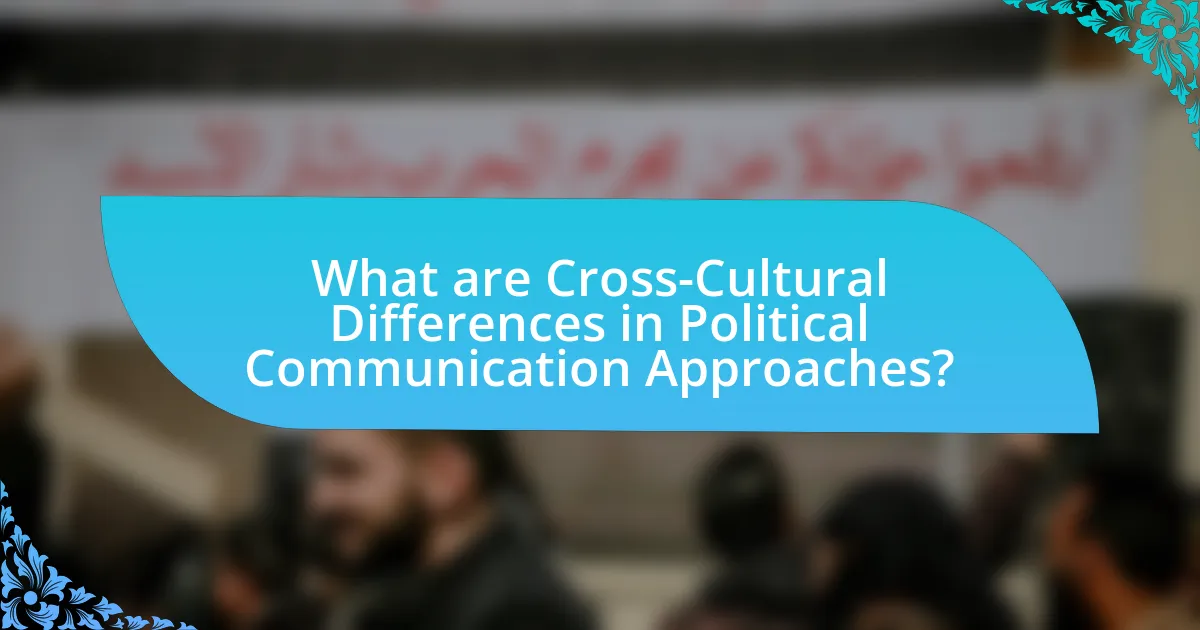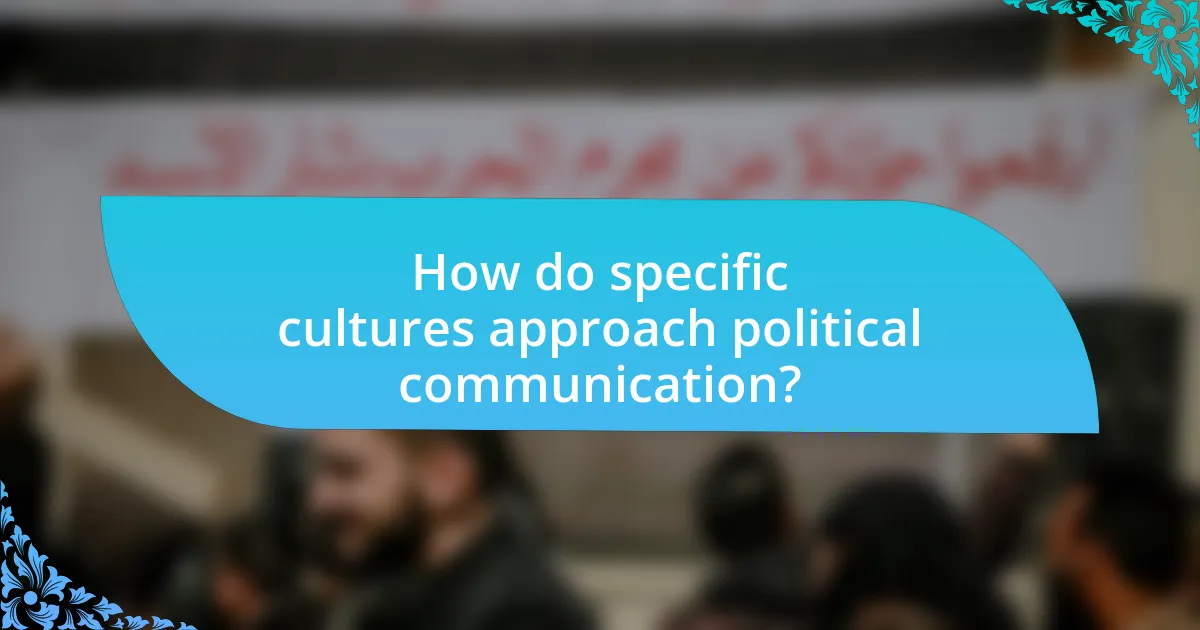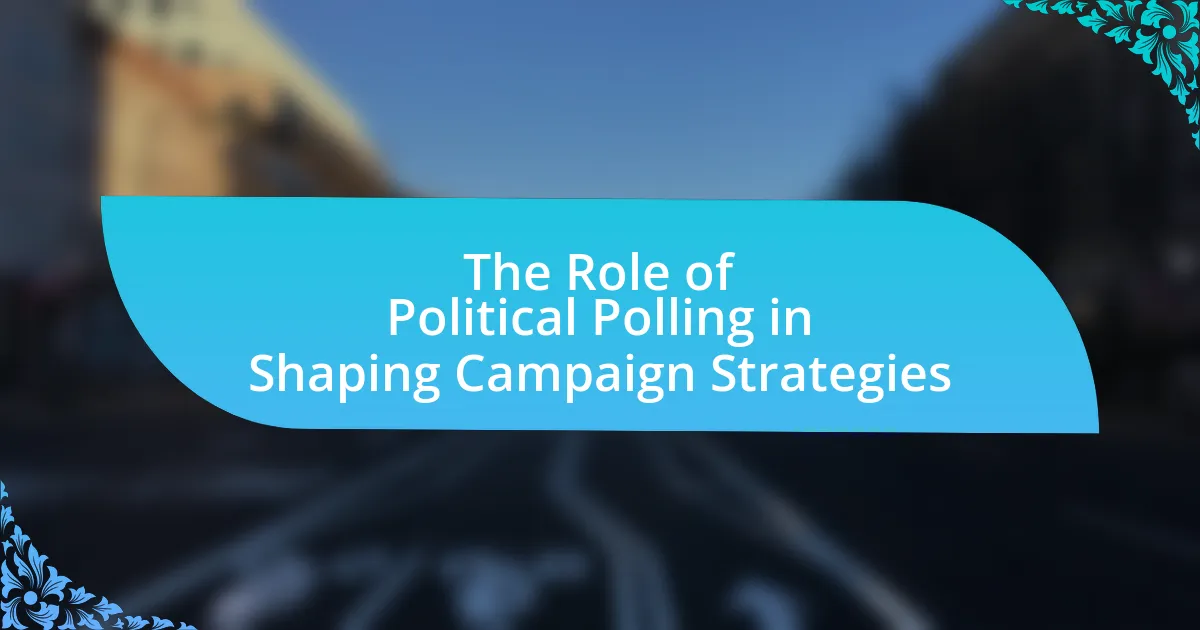Cross-cultural differences in political communication approaches encompass the diverse methods and styles utilized by political entities to convey messages across various cultures. This article examines how cultural values, such as individualism versus collectivism and high-context versus low-context communication, influence political discourse and engagement strategies. It highlights the significance of understanding these differences to enhance diplomatic relations and prevent miscommunication, which can lead to policy failures and public unrest. Additionally, the article explores the impact of language, media channels, and communication styles on political interactions in both Western and Eastern contexts, providing best practices for effective cross-cultural communication.

What are Cross-Cultural Differences in Political Communication Approaches?
Cross-cultural differences in political communication approaches refer to the varying methods and styles used by political entities to convey messages across different cultures. These differences can manifest in verbal communication, non-verbal cues, media usage, and audience engagement strategies. For instance, high-context cultures, such as Japan, often rely on implicit messages and non-verbal communication, while low-context cultures, like the United States, favor direct and explicit messaging. Research by Hall (1976) highlights these distinctions, emphasizing that cultural context significantly influences how political messages are crafted and received. Additionally, studies show that collectivist societies may prioritize group harmony in political discourse, whereas individualistic cultures may focus on personal expression and debate.
How do cultural values influence political communication?
Cultural values significantly influence political communication by shaping the way messages are constructed, interpreted, and received within different societies. For instance, in collectivist cultures, political communication often emphasizes community and group harmony, leading to messages that prioritize consensus and social cohesion. Conversely, in individualistic cultures, political communication tends to focus on personal rights and individual achievements, resulting in messages that highlight personal freedom and self-expression. Research by Hofstede (1980) on cultural dimensions illustrates these differences, showing that societies with high collectivism value group-oriented communication, while those with high individualism favor assertive and direct messaging. This foundational understanding of cultural values is essential for effective political discourse across diverse cultural contexts.
What specific cultural values impact communication styles?
Cultural values such as individualism versus collectivism, high-context versus low-context communication, and power distance significantly impact communication styles. Individualistic cultures, like the United States, prioritize personal expression and direct communication, while collectivist cultures, such as Japan, emphasize group harmony and indirect communication. High-context cultures rely on implicit messages and non-verbal cues, whereas low-context cultures favor explicit verbal communication. Additionally, cultures with high power distance, like many Asian countries, may exhibit more formal communication styles that respect hierarchy, contrasting with low power distance cultures that encourage egalitarian dialogue. These distinctions shape how messages are conveyed and interpreted across different cultural contexts.
How do these values shape political discourse in different cultures?
Values significantly shape political discourse in different cultures by influencing the priorities, communication styles, and engagement methods of political actors. For instance, collectivist cultures, such as those in East Asia, prioritize community and harmony, leading to political discussions that emphasize consensus and group welfare. In contrast, individualistic cultures, like those in the United States, focus on personal rights and freedoms, resulting in more confrontational and debate-oriented political dialogues. Research by Hofstede indicates that these cultural dimensions directly affect how political messages are crafted and received, with collectivist societies favoring indirect communication and individualistic societies embracing direct confrontation. This cultural framework thus dictates not only the content of political discourse but also the strategies employed by politicians to connect with their constituents.
Why is understanding cross-cultural differences important in political communication?
Understanding cross-cultural differences is crucial in political communication because it enables effective engagement with diverse audiences. Political messages can be interpreted differently based on cultural contexts, which can lead to misunderstandings or conflicts if not addressed. For instance, research by Hofstede identifies key dimensions of culture, such as individualism versus collectivism, which influence how political messages are received and processed. Recognizing these differences allows political communicators to tailor their strategies, ensuring that their messages resonate appropriately with various cultural groups, thereby enhancing the effectiveness of political discourse and fostering better international relations.
What are the consequences of miscommunication in political contexts?
Miscommunication in political contexts can lead to significant consequences, including policy failures, diplomatic tensions, and public unrest. For instance, when political leaders misinterpret each other’s statements or intentions, it can result in misguided policies that do not address the actual needs of the populace, as seen in the 2003 Iraq War, where miscommunication about weapons of mass destruction led to a prolonged conflict. Additionally, diplomatic relations can deteriorate due to misunderstandings, exemplified by the 2014 Ukraine crisis, where miscommunication between Russia and Western nations escalated tensions and conflict. Public unrest can also arise from miscommunication, as seen in various protests worldwide, where government messages are misaligned with public sentiment, leading to civil disobedience and unrest. These examples illustrate that miscommunication in political contexts can have far-reaching and detrimental effects on governance and societal stability.
How can awareness of these differences improve diplomatic relations?
Awareness of cross-cultural differences can significantly improve diplomatic relations by fostering mutual understanding and respect among nations. When diplomats recognize and appreciate varying communication styles, values, and social norms, they can tailor their approaches to engage more effectively with their counterparts. For instance, research by the Harvard Kennedy School highlights that cultural misunderstandings often lead to conflicts in negotiations; thus, awareness can mitigate these risks and promote collaboration. By adapting communication strategies to align with cultural expectations, diplomats can build trust, enhance cooperation, and ultimately achieve more favorable outcomes in international relations.

What are the key components of political communication across cultures?
The key components of political communication across cultures include language, cultural context, media channels, and audience engagement. Language serves as the primary medium through which political messages are conveyed, and variations in language can lead to different interpretations of political discourse. Cultural context shapes the values, beliefs, and norms that influence how political messages are received and understood, as evidenced by the differing responses to political campaigns in collectivist versus individualist societies. Media channels, including traditional and digital platforms, play a crucial role in disseminating political information, with preferences varying significantly across cultures; for instance, social media is more influential in younger, tech-savvy populations. Lastly, audience engagement strategies must be tailored to resonate with specific cultural demographics, as demonstrated by the effectiveness of localized messaging in political advertising.
How do language and rhetoric vary in political communication?
Language and rhetoric in political communication vary significantly across cultures, influencing how messages are constructed and received. For instance, in Western political discourse, directness and clarity are often valued, leading to straightforward language and assertive rhetoric. In contrast, many Eastern cultures may prioritize indirect communication and subtlety, employing metaphorical language and nuanced rhetoric to convey messages. This variation is evident in the use of honorifics and politeness strategies in Asian political contexts, which reflect cultural values of respect and hierarchy. Research by Hall (1976) on high-context versus low-context communication highlights these differences, showing that high-context cultures rely on shared understanding and implicit messages, while low-context cultures favor explicit verbal communication.
What role does language play in shaping political messages?
Language plays a crucial role in shaping political messages by influencing how ideas are conveyed and perceived. The choice of words, tone, and structure can significantly affect public interpretation and emotional response. For instance, political leaders often use specific language to evoke patriotism or fear, as seen in George W. Bush’s post-9/11 speeches, which employed terms like “freedom” and “terror” to frame the narrative around national security. Additionally, language can reflect cultural values and norms, impacting how messages resonate across different societies. Research shows that linguistic framing can alter public opinion, as demonstrated in studies by Entman (1993) on media framing effects, highlighting the power of language in political discourse.
How does rhetoric differ between cultures in political contexts?
Rhetoric differs significantly between cultures in political contexts due to varying values, communication styles, and historical backgrounds. For instance, Western cultures often emphasize directness and individualism in political discourse, valuing clarity and logical argumentation, as seen in American political debates. In contrast, many Asian cultures prioritize indirect communication and collectivism, focusing on harmony and consensus, which can be observed in the diplomatic language used in countries like Japan and China. These differences are rooted in cultural frameworks; for example, Edward Hall’s high-context and low-context communication theory illustrates how high-context cultures rely on implicit messages and shared understanding, while low-context cultures depend on explicit verbal communication. This cultural divergence in rhetoric shapes how political messages are crafted and received, influencing public opinion and political engagement across different societies.
What are the different mediums used for political communication globally?
Political communication globally utilizes various mediums, including traditional media, digital platforms, and interpersonal communication. Traditional media encompasses television, radio, and print newspapers, which have historically been primary sources for disseminating political information. Digital platforms, such as social media (e.g., Facebook, Twitter), websites, and blogs, have gained prominence, allowing for real-time interaction and engagement with audiences. Interpersonal communication, including speeches, town hall meetings, and face-to-face discussions, remains vital for direct voter engagement. The effectiveness of these mediums varies across cultures, influenced by factors such as technology access, media literacy, and political context, as evidenced by studies showing differing impacts of social media on political mobilization in various countries.
How do traditional media and social media differ in their impact on political communication?
Traditional media and social media differ significantly in their impact on political communication by the nature of their reach and engagement. Traditional media, such as television and newspapers, typically disseminate information in a one-to-many format, leading to a more controlled narrative shaped by editors and journalists, which can limit public interaction. In contrast, social media platforms enable a many-to-many communication model, allowing for real-time interaction, user-generated content, and diverse viewpoints, which can amplify grassroots movements and facilitate direct engagement between politicians and constituents. For example, during the Arab Spring, social media played a crucial role in mobilizing protests and disseminating information rapidly, showcasing its ability to influence political discourse in ways that traditional media could not match.
What are the cultural preferences for communication mediums in various regions?
Cultural preferences for communication mediums vary significantly across regions, influenced by factors such as technology access, social norms, and historical context. For instance, in North America and Western Europe, digital communication platforms like email and social media are predominant due to high internet penetration and a culture that values immediacy and informality. In contrast, in many Asian cultures, particularly in Japan and South Korea, face-to-face communication and formal written correspondence are preferred, reflecting a cultural emphasis on relationship-building and respect for hierarchy.
Research by the Pew Research Center indicates that 72% of adults in the U.S. use social media, while in Japan, only about 30% engage with these platforms regularly, highlighting the regional differences in communication preferences. Additionally, in parts of Africa, mobile phones are the primary medium for communication, as they provide greater accessibility compared to traditional landlines, with a report from the International Telecommunication Union showing that mobile subscriptions in Africa surpassed 1 billion in 2020. These examples illustrate how cultural values and technological infrastructure shape communication preferences across different regions.

How do specific cultures approach political communication?
Specific cultures approach political communication through distinct methods shaped by their historical, social, and cultural contexts. For instance, in collectivist cultures like Japan, political communication often emphasizes harmony and consensus, reflecting societal values that prioritize group cohesion over individual expression. In contrast, individualistic cultures such as the United States tend to favor direct and assertive communication styles, where personal opinions and debates are encouraged, reflecting a value system that prioritizes individual rights and freedoms. Research indicates that these cultural orientations significantly influence how political messages are crafted and received, impacting voter engagement and public discourse.
What are the communication styles prevalent in Western political contexts?
In Western political contexts, prevalent communication styles include directness, assertiveness, and a focus on clarity and transparency. These styles emphasize straightforward language and the importance of logical reasoning, often reflecting cultural values such as individualism and democratic principles. For instance, political speeches and debates in countries like the United States and the United Kingdom typically prioritize clear articulation of policies and positions, allowing for public scrutiny and debate. Research by Hall (1976) highlights that Western cultures favor low-context communication, where messages are explicit and the burden of understanding lies primarily with the speaker. This contrasts with high-context cultures, where much of the communication relies on implicit understanding and non-verbal cues.
How does direct communication influence political effectiveness in the West?
Direct communication significantly enhances political effectiveness in the West by fostering transparency and trust between politicians and constituents. This form of communication allows for immediate feedback, enabling leaders to address public concerns swiftly and adapt their policies accordingly. For instance, studies show that politicians who engage directly with their constituents through town hall meetings or social media platforms tend to have higher approval ratings and voter engagement. According to a 2020 Pew Research Center report, 64% of Americans believe that direct communication from elected officials improves their understanding of political issues, thereby increasing civic participation and accountability.
What are the challenges faced in Western political communication?
The challenges faced in Western political communication include misinformation, polarization, and the impact of social media. Misinformation undermines public trust and distorts political discourse, as evidenced by the rise of fake news during major elections, such as the 2016 U.S. presidential election. Polarization creates an environment where individuals are less willing to engage with opposing viewpoints, leading to echo chambers that reinforce biases. Additionally, social media platforms amplify these issues by prioritizing sensational content over factual reporting, which has been shown to influence public opinion and voter behavior significantly.
What are the communication styles prevalent in Eastern political contexts?
Communication styles prevalent in Eastern political contexts often emphasize indirectness, collectivism, and high-context communication. In these settings, messages are frequently conveyed through non-verbal cues, context, and relationships rather than explicit verbal statements. For instance, in countries like Japan and China, maintaining harmony and face-saving is crucial, leading to a preference for subtlety and nuance in political discourse. Research indicates that leaders in these regions often utilize metaphor and allegory to communicate complex ideas, reflecting cultural values that prioritize group consensus over individual expression. This approach contrasts sharply with Western styles, which tend to favor directness and individualism.
How does indirect communication shape political interactions in the East?
Indirect communication significantly shapes political interactions in the East by fostering a culture of subtlety and context over direct confrontation. In many Eastern societies, such as Japan and China, political discourse often relies on non-verbal cues, implied meanings, and a deep understanding of social hierarchies, which can lead to more harmonious relationships and avoid open conflict. For instance, in China, the concept of “face” emphasizes the importance of maintaining dignity and respect in communication, influencing how political messages are conveyed and received. This indirect approach can facilitate consensus-building and negotiation, as seen in diplomatic discussions where parties may avoid explicit disagreement to preserve relationships.
What unique challenges arise in Eastern political communication approaches?
Eastern political communication approaches face unique challenges such as the influence of collectivist cultural values, which prioritize group harmony over individual expression. This cultural context often leads to indirect communication styles, making it difficult for political messages to be clearly understood or for dissenting opinions to be voiced openly. Additionally, state control over media and information dissemination in many Eastern countries restricts the flow of diverse viewpoints, further complicating public discourse. For instance, in countries like China, the government’s censorship policies limit the ability of citizens to engage in open political discussions, thereby stifling democratic engagement and critical debate.
What best practices can enhance cross-cultural political communication?
Best practices that can enhance cross-cultural political communication include active listening, cultural sensitivity, and the use of clear, simple language. Active listening fosters understanding by ensuring that all parties feel heard and valued, which is crucial in diverse cultural contexts. Cultural sensitivity involves recognizing and respecting differences in values, beliefs, and communication styles, which can prevent misunderstandings and build trust. The use of clear, simple language minimizes the risk of misinterpretation, especially when language barriers exist. Research indicates that effective cross-cultural communication can lead to more successful diplomatic negotiations and improved international relations, as seen in the work of the United Nations in fostering dialogue among member states.
How can political leaders adapt their communication strategies for diverse audiences?
Political leaders can adapt their communication strategies for diverse audiences by employing culturally relevant messaging, utilizing various communication channels, and actively engaging with community representatives. Culturally relevant messaging ensures that the language, symbols, and values resonate with specific groups, which is supported by research indicating that tailored communication increases message effectiveness (Hofstede, 2001). Utilizing various communication channels, such as social media, traditional media, and community events, allows leaders to reach different demographics effectively, as evidenced by the varied media consumption habits across age and cultural groups (Pew Research Center, 2021). Actively engaging with community representatives fosters trust and provides insights into the audience’s needs and preferences, which is crucial for effective political communication (Bennett & Segerberg, 2013).
What tools and techniques can facilitate effective cross-cultural communication?
Effective cross-cultural communication can be facilitated through tools such as translation services, cultural training programs, and communication technology, alongside techniques like active listening, empathy, and adaptability. Translation services ensure accurate message delivery across languages, while cultural training programs enhance understanding of diverse cultural norms and values, which is crucial in political contexts. Communication technology, including video conferencing and collaborative platforms, allows for real-time interaction, bridging geographical gaps. Techniques like active listening promote engagement and understanding, empathy fosters connection by acknowledging different perspectives, and adaptability enables individuals to adjust their communication styles to suit various cultural contexts. These tools and techniques collectively enhance clarity and reduce misunderstandings in cross-cultural interactions, particularly in political communication.

















